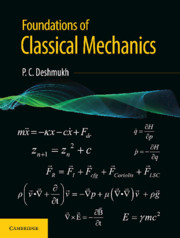Book contents
- Frontmatter
- Dedication
- Contents
- List of Figures
- List of Tables
- Foreword
- Preface
- Introduction
- 1 Laws of Mechanics and Symmetry Principles
- 2 Mathematical Preliminaries
- 3 Real Effects of Pseudo-forces: Description of Motion in Accelerated Frame of Reference
- 4 Small Oscillations and Wave Motion
- 5 Damped and Driven Oscillations; Resonances
- 6 The Variational Principle
- 7 Angular Momentum and Rigid Body Dynamics
- 8 The Gravitational Interaction in Newtonian Mechanics
- 9 Complex Behavior of Simple System
- 10 Gradient Operator, Methods of Fluid Mechanics, and Electrodynamics
- 11 Rudiments of Fluid Mechanics
- 12 Basic Principles of Electrodynamics
- 13 Introduction to the Special Theory of Relativity
- 14 A Glimpse of the General Theory of Relativity
- Index
10 - Gradient Operator, Methods of Fluid Mechanics, and Electrodynamics
Published online by Cambridge University Press: 06 November 2019
- Frontmatter
- Dedication
- Contents
- List of Figures
- List of Tables
- Foreword
- Preface
- Introduction
- 1 Laws of Mechanics and Symmetry Principles
- 2 Mathematical Preliminaries
- 3 Real Effects of Pseudo-forces: Description of Motion in Accelerated Frame of Reference
- 4 Small Oscillations and Wave Motion
- 5 Damped and Driven Oscillations; Resonances
- 6 The Variational Principle
- 7 Angular Momentum and Rigid Body Dynamics
- 8 The Gravitational Interaction in Newtonian Mechanics
- 9 Complex Behavior of Simple System
- 10 Gradient Operator, Methods of Fluid Mechanics, and Electrodynamics
- 11 Rudiments of Fluid Mechanics
- 12 Basic Principles of Electrodynamics
- 13 Introduction to the Special Theory of Relativity
- 14 A Glimpse of the General Theory of Relativity
- Index
Summary
There is no greater burden than an unfulfilled potential.
—Charles M. SchulzTHE SCALAR FIELD, DIRECTIONAL DERIVATIVE, AND GRADIENT
In the discussion on Fig. 2.4 (Chapter 2), we learned that it was neither innocuous to define a vector merely as a quantity that has both direction and magnitude, nor to define a scalar simply as a quantity that has magnitude alone. It is not that the properties referred here of a scalar and a vector are invalid. Rather, it is to be understood that these properties do not provide an unambiguous definition. Only a signature criterion of a physical quantity can be used to define it. We therefore introduced, in Chapter 2, comprehensive definitions of the scalar as a tensor of rank 0, and of the vector as a tensor of rank 1. In this chapter we shall acquaint ourselves with the mathematical framework in which the laws of fluid mechanics and electrodynamics are formulated using vector algebra and vector calculus. In fact, the techniques are used not merely in these two important branches of classical mechanics, but also in very various other subdivisions of physics. The background material seems at times to be intensely mathematical, but that is only because the laws of nature engage a mathematical formulation very intimately, as we encounter repeatedly in the analysis of physical phenomena. There are many excellent books in college libraries from which one can master the mathematical methods. These topics are extremely enjoyable to learn; they help us develop rigorous insights in the laws of nature. The literature on these topics is vast. A couple of illustrative books [1, 2] are suggested for further reading.
We consider the example of a particular scalar function, namely the temperature distribution in a room. The temperature is a physical property at a particular point in space, such as the point P in Fig. 10.1. Depending on the distribution of the sources of heat in the region that surrounds the point P, temperature may be different from point to point in space, and also possibly from time to time. The reason the temperature at a point is a scalar, is that its value at that point is independent of where the observer's frame of reference is located, and also independent of how it is oriented.
- Type
- Chapter
- Information
- Foundations of Classical Mechanics , pp. 347 - 383Publisher: Cambridge University PressPrint publication year: 2019



